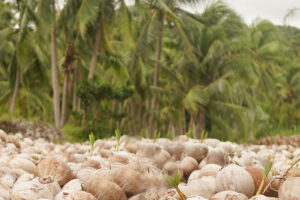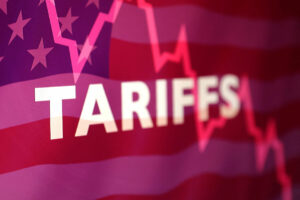Coco farmers seeking to press US tariff advantage

By Aubrey Rose A. Inosante, Reporter
COCONUT FARMERS and exporters are gearing up to increase sales to the US, taking advantage of favorable tariffs relative to other regional producers.
In an e-mail interview with BusinessWorld, Charles R. Avila, president of the Confederation of Coconut Farmers’ Organizations of the Philippines said it will work with exporters to grab more US market share.
The organization “will welcome a possible increase in investor re-locators to the Philippines (and) cooperate with both public and private sectors on a massive coconut planting, re-planting and fertilization program,” he said.
Mr. Avila also anticipates a “dramatic rise” in coconut product prices due to the new US tariff regime.
The Philippines exported $12.14 billion to the US in 2024, of which coconut oil accounted for $558.74 million.
Other related goods exports include $74.24 million in desiccated coconut and $53.70 million in other coconut products.
Speaking on Teleradyo Serbisyo on April 12, Trade Secretary Cristina A. Roque said agricultural exports such as coconut and mangoes will now have an edge against products from neighboring countries with higher tariffs.
“We were losing out on coconut sales to Thailand because their tariffs were lower before. But now, our tariff is 17%, while theirs is 34%. So that’s a big deal,” Ms. Roque said.
Thailand, a major global producer and exporter of coconut product such as the coconut milk exported $341.11 million worth of coconut milk between January and October 2024, according to the Thai Government Public Relations Department.
It said that the US accounted for 70.5% of the country’s total coconut milk exports.
Ms. Roque noted that the tariff advantage would likely lead to increased US imports from the Philippines, despite a general rise in product prices.
“The prices of our goods will also rise but the prices of goods from other Southeast Asian Nations (ASEAN) countries will be higher,” Ms. Roque said.
The US imposed some of the highest tariffs on ASEAN countries on April 2, with the Philippines having the second-lowest tariff rate in the region.
The worst of the US tariffs were assigned to Cambodia (49%), Laos (48%), Vietnam (46%), Myanmar (44%), Thailand (36%), Indonesia (32%), Malaysia (24%), and Brunei (24%).
Mr. Avila emphasized that “tariffs are not everything” and the global competitiveness will ultimately rest on production costs.
“The Philippines might be favored with relatively low tariffs but if its production costs continue to be higher because of the proverbial government corruption and inefficiency in all that it does, then there is very little hope not only for the coconut industry but for the national economy as a whole,” he said.
Mr. Avila said Romeo I. Chan, president of Axelum Resources Corp., is currently in the US to look into the impact of the tariffs on the coconut supply chain.
Axelum is a listed integrated manufacturer and exporter of premium coconut products.
Ms. Roque and Secretary Frederick D. Go, the Special Assistant to the President for Investment and Economic Affairs, are expected to fly to Washington “toward the middle of May” for negotiations with the US Trade Representative (USTR).
“We will really discuss the close relationship between the Philippines and the US. We will also discuss our long-term trade partnerships with the US,” she added.
Ms. Roque brushed off concerns on the tariffs, saying that the Philippines is in “good position” compared to ASEAN peers.
Philippine Exporters Confederation, Inc. President Sergio R. Ortiz-Luis, Jr. the Philippines is in no position to negotiate with the US.
“Napakaliit natin to be able to come up with something just for us (we’re too small for special treatment). Baka ’yung ASEAN pag ’yung may tsansa. (Maybe our chances will improve as a bloc)… I don’t think there’s much we can offer,” he said by telephone on April 11.
Mr. Ortiz-Luis said the blanket 10% tariff imposed during the stay of implementation of the initially-announced tariff schedule levels the playing field and highlights the importance of cost competitiveness.
“We have to really look at our competitiveness and to be able to cut down our costs to be able to compete,” he said.
Former tariff commissioner George N. Manzano said the priority during the pause should finding out what the USTR’s demands are with regard to Philippine trade policy, which would lead to a lowering of the reciprocal tariffs.
“I am not sure if the US will agree to a zero for zero. They will ask for higher tariffs on certain industries such as steel, cars and ships, etc. because they want to protect those products,” Mr. Manzano said, noting that he is speculating about potential outcomes.
Mr. Go has said that the best possible outcome for the Philippine is a “free trade agreement — zero tariffs on both sides.”



